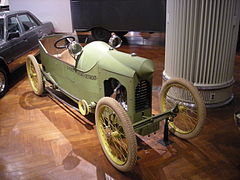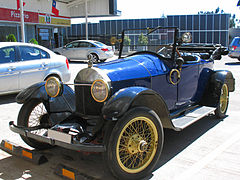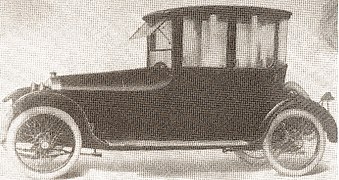Scripps-Booth
Parent General Motors | | |

Scripps-Booth was a
History
The company was founded by artist and engineer
Reliability issues with the Sterling engine in early cars caused the engine to be changed to a Chevrolet 490 in the Model G. James Booth believed the company should build their own engines and when company directors declined to do this, Booth resigned.[2]
In 1916, Scripps-Booth Company consolidated with the Sterling Motor Company to become the publicly traded Scripps-Booth Corporation.[4] By the end of 1917, Scripps-Booth had been purchased by Chevrolet whose founder William C. Durant was also the founding president of Sterling Motor Company.[5] Billy Durant regained control of General Motors and Scripps-Booth became a division of GM with A. H. Sarver as president.
The Scripps-Booth cars were now built with
-
1913 Scripps-Booth Rocket Cyclecar at the Henry Ford Museum
-
1916 Scripps-Booth Model C Roadster at Tallahassee Automobile Museum
-
1918 Scripps-Booth Model D roadster in Chile
-
A 1920s Scripps-Booth showroom
-
1921 Scripps-Booth sedan in front of a showroom
Vehicles
The Vintage Chevrolet Club of America accepts the following Scripps-Booth models:[6]
- Model C Roadster, 1915–17
- Model G Roadster, 1917–19
- Model D 4 Passenger Roadster, 1916–17
- Model H 4 Passenger, 4 Door Touring, 1918
For 1914, Scripps-Booth offered a three-passenger
The 1916-17 Model D was powered by an overhead valve V8 engine[9] designed by Alanson Brush.[10]
-
1914 Scripps-Booth Rocket Cyclecar
-
1915 Sripps-Booth Coupe
-
1916 Scripps-Booth Coupe
-
1916 Scripps-Booth Vitesse Roadster
-
1917Scripps-booth Model D
-
1918 Scripps-Booth Roadster
-
1919 Scripps-Booth Six-39
-
1920 Scripps Booth Model B-45 Coupe
-
1921 Scripps-Booth Model B-39
-
1922 Scripps-Booth Model F-45
In popular culture
Before marrying the main character in John O'Hara's 1934 novel Appointment in Samarra, a youthful Caroline Walker drives a Scripps-Booth Model C Roadster. The car's unusual seating arrangement, in which "the driver sat a foot or so forward of the other seat, which made kissing an awkward act", is especially noted.[11]
Groucho Marx owned a Scripps-Booth.
See also
References
- ^ Clymer, Floyd. Treasury of Early American Automobiles, 1877-1925 (New York: Bonanza Books, 1950), p.115.
- ^ ISBN 978-0-87341-428-9.
- ^ ISBN 1-57958-293-1.
- ^ New York Times, August 9, 1916
- ^ Chevrolet U.S. and Canadian Production Figures 1912-1931, Kaufmann/Hayward 2002
- ^ 1914-22 Scripps-Booth
- ^ Clymer, Floyd. Treasury of Early American Automobiles, 1877-1925 (New York: Bonanza Books, 1950), p.149.
- ^ a b c d e f g h i Clymer, p.149.
- ^ Cars by Lou Phillips
- ^ Hemmings Muscle Machines April, 2004
- ISBN 0-679-60110-4
External links
- Bill Cuthbert, "The Machines of James Scripps-Booth," HCCA Horseless Carriage Gazette, Sept-Oct 2014, pp. 26–29
- Sam Medway, Automobile Quarterly, 13(3), 1975
- Scripps-Booth Register - An organization for Scripps-Booth history and preservation of extant cars
- Scripps-Booth at ConceptCarz
- 1913 Scripps-Booth Bi-Autogo, called one of the "Worst Cars of All Time"















